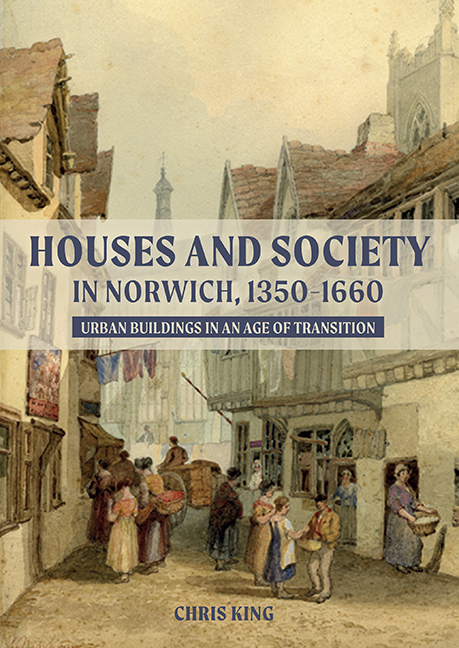Book contents
- Frontmatter
- Dedication
- Contents
- List of plates and figures
- List of tables
- Acknowledgements
- List of Abbreviations
- 1 Urban rebuildings, urban transitions
- 2 Norwich, 1350–1660: continuity and change in an English provincial city
- 3 Medieval merchants’ houses, c.1350–1540
- 4 Early modern merchants’ houses, c.1540–1660
- 5 The urban elite: domestic space, social identity and civic authority
- 6 Medieval houses and the urban ‘great rebuilding’
- 7 Houses of the ‘middling sort’: buildings and the use of space
- 8 Housing the urban poor and immigrant communities
- Conclusions
- Glossary
- Bibliography
- Index
- Plate Section
6 - Medieval houses and the urban ‘great rebuilding’
Published online by Cambridge University Press: 23 October 2020
- Frontmatter
- Dedication
- Contents
- List of plates and figures
- List of tables
- Acknowledgements
- List of Abbreviations
- 1 Urban rebuildings, urban transitions
- 2 Norwich, 1350–1660: continuity and change in an English provincial city
- 3 Medieval merchants’ houses, c.1350–1540
- 4 Early modern merchants’ houses, c.1540–1660
- 5 The urban elite: domestic space, social identity and civic authority
- 6 Medieval houses and the urban ‘great rebuilding’
- 7 Houses of the ‘middling sort’: buildings and the use of space
- 8 Housing the urban poor and immigrant communities
- Conclusions
- Glossary
- Bibliography
- Index
- Plate Section
Summary
THE previous three chapters discussed in detail the houses belonging primarily to Norwich's wealthy mercantile elite; it is now time to turn our attention to the dwellings of the greater part of the inhabitants, which of course made up the vast majority of the city's housing stock. The houses which are covered in the second half of this book vary in size and status, ranging from substantial two- and three-storey dwellings inhabited by prosperous tradespeople and craftsmen, the ‘middling sort’ of the medieval and early modern city, down to single-cell buildings which were the homes of ordinary artisans, labourers and the urban poor. This is a very broad spectrum of the urban population, and it is rarely possible to make definitive statements about the relationship between social and economic status and house size and form. The urban built environment was complex and fluid – urban households might expand or contract their living and working space according to changes in their economic status or family lifecycle; urban neighbourhoods often contained different status groups living in close proximity, while, over time, as we will discover, larger houses were often divided into smaller units as the population increased in the early modern period.
As discussed in Chapter 2, however, Norwich contains a uniquely large and well-preserved body of evidence for exploring the development of medieval and early modern urban domestic buildings in the form of both surviving structures and extensive excavations of urban tenements conducted over the past 50 years, alongside a significant body of documentary sources which can inform us about urban social groups and their spatial and material environment. Together these provide probably our best opportunity from any English provincial city to understand the construction and layout of urban houses across a range of different neighbourhoods and status groups from the middling sort to the urban poor, and to explore the complex relationship between domestic architecture and social and economic transformations in the medieval to early modern transition.
The discussion of these topics is divided across three chapters. Chapter 6 deals with the evidence for non-elite housing in Norwich in the period between the mid-fourteenth and mid-sixteenth centuries.
- Type
- Chapter
- Information
- Houses and Society in Norwich, 1350–1660Urban Buildings in an Age of Transition, pp. 177 - 214Publisher: Boydell & BrewerPrint publication year: 2020



